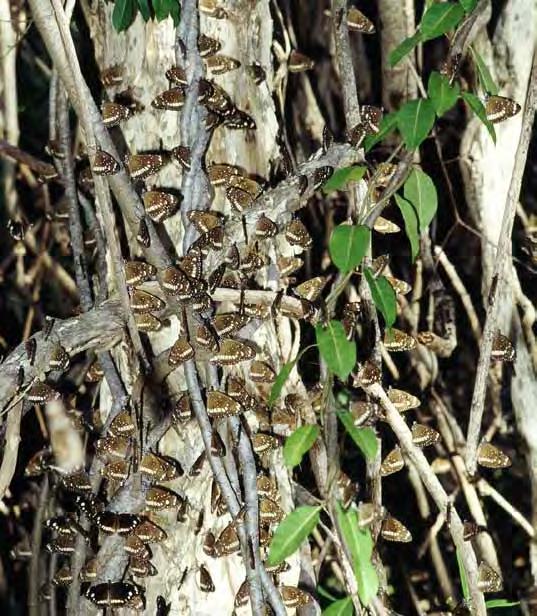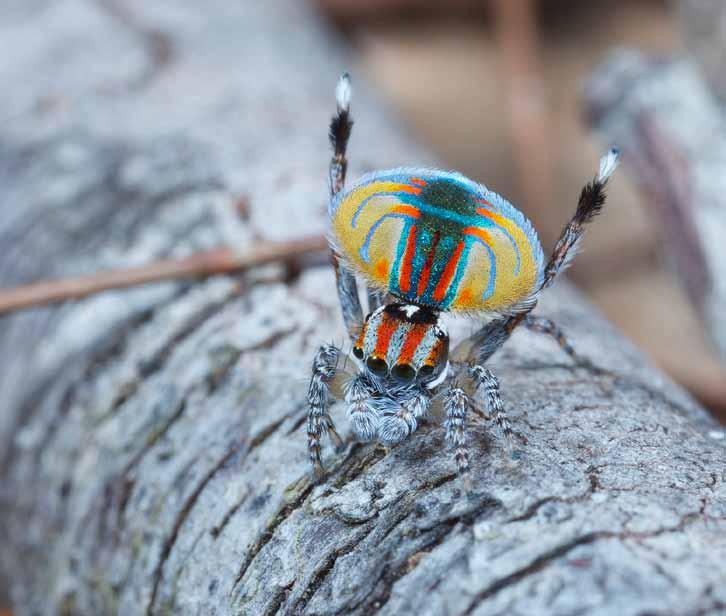
4 minute read
In your backyard with Martyn Robinson
MARTYN ROBINSON
is the museum’s resiDent naturalist
BRoken sLeeP
When I was a child in suburban Sydney there were a number of insects which you only ever saw in summer if the summer was very hot and the winds were from the north or north-east.
Now many of these insects are to be found every summer and sometimes at other times of the year too. One of these is the Common Crow butterfly, Euploea core corinna.
It’s the caterpillar and – even more so – the pupa (chrysalis) of this species that usually attracts everyone’s attention. The caterpillar is stripy with six tendrils rising from its body, and the chrysalis is an almost unphotographable blob of mercury silver or shining gold. To top it off, the caterpillars are often found feasting on highly poisonous Oleander shrubs. The adult butterfly by contrast is a dingy dark colour with white spots – not a showy insect in comparison with its earlier life stages. This doesn’t mean, however, that it isn’t interesting. For a butterfly, it is very interesting! It is one of the butterflies that ‘hibernates’ through the winter months. Butterfly hibernation isn’t quite the still, cryptic state of torpor found in other animals. Most hibernating butterfly species hang in clusters exposed among the foliage of selected trees, and on warm winter days they will fly about for short distances, perhaps visiting a nearby creek bank to drink before returning to their roost. The Common Crow is one of these and has long been known to form clusters numbering from about a dozen to a hundred or more around Brisbane and further north. Nowadays these
Left
Common Crow butterflies clustering in winter along a dry creek bed near Charters towers, 100 km southeast of townsville, Qld. Photo © elly scheermeyer.
Opposite
a male peacock spider, Maratus volans, displaying his finery to a potential mate. Photo © Jürgen otto.
clusters, though smaller than in the north, can be found as far south as Sydney. They are an annual occurrence in certain areas and are most common near wet, rocky overhangs. When springtime comes around, the clusters disperse and the butterflies are off to an early start, ready to find food and breed while the eggs of other butterfly species are still hatching. It is tempting to regard these overwintering clusters as yet another sign of climate change – and they may well be – but a simpler explanation is that urban areas tend to be warmer during winter because of heat stored in concrete and radiation from homes such that quite a few suburban areas no longer experience winter frosts (deadly to butterflies). It is from these frost-free areas that the butterflies find their overwintering spots and they are still absent from frost-affected areas. Mind you, it could be just a matter of time before frost itself becomes a distant memory.
WEBLINK
explore common crow biology at abc.net.au/science/articles/2000/07/20/2689015.htm
My 2013 cALenDAR
Most years I have a calendar on my wall with nice monthly photographs of natural history subjects. This year’s is particularly spectacular – and unusual – for all the images are of spiders. Not just any spiders either, but members of a single genus of native Australian spiders which combine brilliant gaudy colour, unusual flamboyant behavior, extreme sexual dimorphism and tiny size. They are known as peacock spiders and are now placed in the genus Maratus. When they were first described, it was noted that the male spider possessed tiny flaps that folded around the sides of his colourful abdomen. What could these flaps be for? Well, they resembled the gliding membranes of gliding possums and ‘flying’ squirrels, and one early anecdotal report claimed they’d been seen to help the spider glide. In fact, an earlier name for the species was Attus volans – the Flying Spider. The puzzle didn’t end there – every single specimen found was a male. Obviously the female must look different to the male, as there were no obvious female specimens with such flaps and colours, despite searches in areas where males had been found. Even the males, at around 4–5 mm, were not easy to find. It was not until recently that Jürgen Otto was to identify and photograph the female of the species and prove that the male’s flaps are not for gliding but a colourful courtship display. When unfurled the flaps form a fan like a peacock’s tail and are similarly brandished in courtship display, leading to the whole genus now being called peacock spiders. This behaviour was described – and ignored – way back in 1957 by RA Dunn for a related species, and it was Dunn who coined the term ‘peacock spiders’. Initially there were very few species named but recent research by Jürgen Otto, David Hill, Julianne Waldock and some enthusiastic amateur photographers has revealed more than 22 species so far. Many have spectacular displays, abdominal flaps and different patterns in the males as well as drab-coloured females. The reason for these patterns becomes obvious when you consider that in one small area there may be several species of these tiny brightly coloured spiders. The males will display to females of other species, and so presumably it is up to the female to determine which male is the correct species for her to mate with. And what better way to do this than check out his colour patterns and distinctive courtship dance? The males on the other hand must get things right – even if he is courting the correct female of his species, he could still end up as dinner!

WEBLINK
find more of Jürgen otto’s photographs on flickr.com

